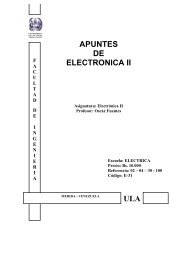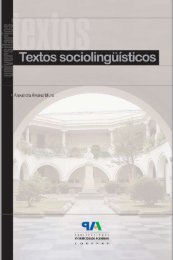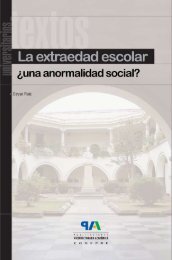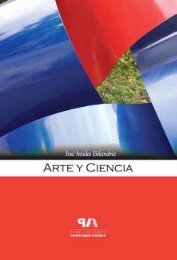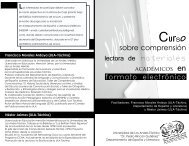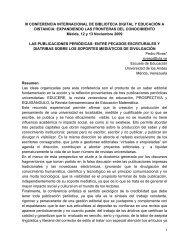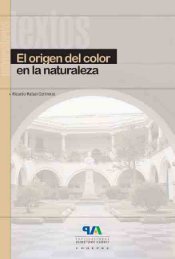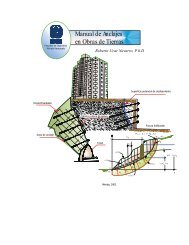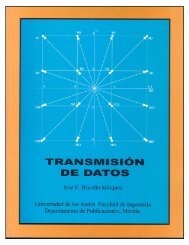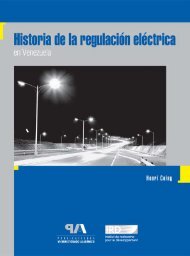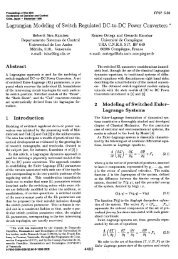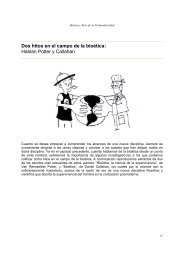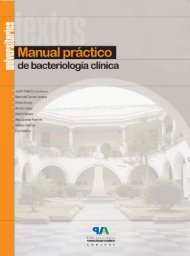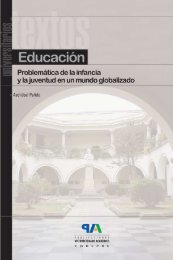Passivity-based Control of Euler-Lagrange Systems:
Passivity-based Control of Euler-Lagrange Systems:
Passivity-based Control of Euler-Lagrange Systems:
Create successful ePaper yourself
Turn your PDF publications into a flip-book with our unique Google optimized e-Paper software.
xx<br />
CONTENTS<br />
3.1 PBC is downward compatible with FOC . . . . . . . . . . . . 392<br />
3.2 Stability <strong>of</strong>indirect FOC for known parameters . . . . . . . . 393<br />
4 Experimental comparison <strong>of</strong> PBC and feedback linearization . . . . . 394<br />
4.1 Experimental setup . . . . . . . . . . . . . . . . . . . . . . . . 395<br />
4.2 Selection <strong>of</strong> ux reference in experiments . . . . . . . . . . . . 398<br />
4.3 Speed tracking performance . . . . . . . . . . . . . . . . . . . 399<br />
4.4 Robustness and disturbance attenuation . . . . . . . . . . . . 401<br />
4.5 Conclusion . . . . . . . . . . . . . . . . . . . . . . . . . . . . . 402<br />
5 Robust stability <strong>of</strong>PBC . . . . . . . . . . . . . . . . . . . . . . . . . 403<br />
5.1 Global boundedness . . . . . . . . . . . . . . . . . . . . . . . . 404<br />
5.2 Coordinate changes and uniqueness <strong>of</strong> equilibrium . . . . . . . 405<br />
5.3 Local asymptotic stability . . . . . . . . . . . . . . . . . . . . 409<br />
5.4 Global exponential stability . . . . . . . . . . . . . . . . . . . 410<br />
6 O{line tuning <strong>of</strong> PBC . . . . . . . . . . . . . . . . . . . . . . . . . . 415<br />
6.1 Problem formulation . . . . . . . . . . . . . . . . . . . . . . . 416<br />
6.2 Change <strong>of</strong> coordinates . . . . . . . . . . . . . . . . . . . . . . 417<br />
6.3 Local stability . . . . . . . . . . . . . . . . . . . . . . . . . . . 418<br />
6.4 A performance evaluation method <strong>based</strong> on passivity . . . . . 420<br />
6.5 Illustrative examples . . . . . . . . . . . . . . . . . . . . . . . 425<br />
7 Discrete{time implementation <strong>of</strong> PBC . . . . . . . . . . . . . . . . . 429<br />
7.1 The exact discrete{time model <strong>of</strong> the induction motor . . . . . 431<br />
7.2 Analysis <strong>of</strong> discrete{time PBC . . . . . . . . . . . . . . . . . . 432<br />
7.3 A new discrete-time control algorithm . . . . . . . . . . . . . 433<br />
7.4 Discussion <strong>of</strong> discrete{time controller . . . . . . . . . . . . . . 435<br />
7.5 Experimental results . . . . . . . . . . . . . . . . . . . . . . . 435<br />
8 Conclusions and further research . . . . . . . . . . . . . . . . . . . . 438<br />
12 Feedback interconnected systems: Robots with AC drives 441<br />
1 Introduction . . . . . . . . . . . . . . . . . . . . . . . . . . . . . . . . 442<br />
1.1 Cascaded systems . . . . . . . . . . . . . . . . . . . . . . . . . 442<br />
1.2 Robots with AC drives . . . . . . . . . . . . . . . . . . . . . . 445<br />
2 General problem formulation . . . . . . . . . . . . . . . . . . . . . . . 446



